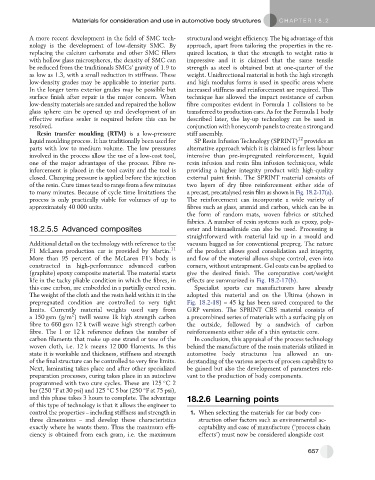Page 649 - Automotive Engineering Powertrain Chassis System and Vehicle Body
P. 649
Materials for consideration and use in automotive body structures C HAPTER 18.2
A more recent development in the field of SMC tech- structural and weight efficiency. The big advantage of this
nology is the development of low-density SMC. By approach, apart from tailoring the properties in the re-
replacing the calcium carbonate and other SMC fillers quired location, is that the strength to weight ratio is
with hollow glass microspheres, the density of SMC can impressive and it is claimed that the same tensile
be reduced from the traditionals SMCs’ gravity of 1.9 to strength as steel is obtained but at one-quarter of the
as low as 1.3, with a small reduction in stiffness. These weight. Unidirectional material in both the high strength
low-density grades may be applicable to interior parts. and high modulus forms is used in specific areas where
In the longer term exterior grades may be possible but increased stiffness and reinforcement are required. This
surface finish after repair is the major concern. When technique has allowed the impact resistance of carbon
low-density materials are sanded and repaired the hollow fibre composites evident in Formula 1 collisions to be
glass sphere can be opened up and development of an transferred to production cars. As for the Formula 1 body
effective surface sealer is required before this can be described later, the lay-up technology can be used in
resolved. conjunction with honeycomb panels to create a strong and
Resin transfer moulding (RTM) is a low-pressure stiff assembly.
liquid moulding process. It has traditionally been used for SP Resin Infusion Technology (SPRINT) 12 provides an
parts with low to medium volume. The low pressures alternative approach which it is claimed is far less labour
involved in the process allow the use of a low-cost tool, intensive than pre-impregnated reinforcement, liquid
one of the major advantages of the process. Fibre re- resin infusion and resin film infusion techniques, while
inforcement is placed in the tool cavity and the tool is providing a higher integrity product with high-quality
closed. Clamping pressure is applied before the injection external paint finish. The SPRINT material consists of
of the resin. Cure times tend to range from a few minutes two layers of dry fibre reinforcement either side of
to many minutes. Because of cycle time limitations the a precast, precatalysed resin film as shown in Fig. 18.2-17(a).
process is only practically viable for volumes of up to The reinforcement can incorporate a wide variety of
approximately 40 000 units. fibres such as glass, aramid and carbon, which can be in
the form of random mats, woven fabrics or stitched
fabrics. A number of resin systems such as epoxy, poly-
18.2.5.5 Advanced composites ester and bismaelimide can also be used. Processing is
straightforward with material laid up in a mould and
Additional detail on the technology with reference to the vacuum bagged as for conventional prepreg. The nature
F1 McLaren production car is provided by Martin. 11 of the product allows good consolidation and integrity,
More than 95 percent of the McLaren F1’s body is and flow of the material allows shape control, even into
constructed in high-performance advanced carbon corners, without entrapment. Gel coats can be applied to
(graphite) epoxy composite material. The material starts give the desired finish. The comparative cost/weight
life in the tacky pliable condition in which the fibres, in effects are summarized in Fig. 18.2-17(b).
this case carbon, are embedded in a partially cured resin. Specialist sports car manufacturers have already
The weight of the cloth and the resin held within it in the adopted this material and on the Ultima (shown in
prepregnated condition are controlled to very tight Fig. 18.2-18) – 45 kg has been saved compared to the
limits. Currently material weights used vary from GRP version. The SPRINT CBS material consists of
2
a 150 gsm (g/m ) twill weave 1k high strength carbon a precombined series of materials with a surfacing ply on
fibre to 660 gsm 12 k twill weave high strength carbon the outside, followed by a sandwich of carbon
fibre. The 1 or 12 k reference defines the number of reinforcements either side of a thin syntactic core.
carbon filaments that make up one strand or tow of the In conclusion, this appraisal of the process technology
woven cloth, i.e. 12 k means 12 000 filaments. In this behind the manufacture of the main materials utilized in
state it is workable and thickness, stiffness and strength automotive body structures has allowed an un-
of the final structure can be controlled to very fine limits. derstanding of the various aspects of process capability to
Next, laminating takes place and after other specialized be gained but also the development of parameters rele-
preparation processes, curing takes place in an autoclave vant to the production of body components.
programmed with two cure cycles. These are 125 C2
bar (250 F at 30 psi) and 125 C 5 bar (250 F at 75 psi),
and this phase takes 3 hours to complete. The advantage 18.2.6 Learning points
of this type of technology is that it allows the engineer to
control the properties – including stiffness and strength in 1. When selecting the materials for car body con-
three dimensions – and develop these characteristics struction other factors such as environmental ac-
exactly where he wants them. Thus the maximum effi- ceptability and ease of manufacture (‘process chain
ciency is obtained from each gram, i.e. the maximum effects’) must now be considered alongside cost
657

